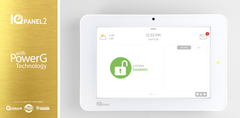Alarm Grid Video Recap: May 21st - 24th
Posted By Michael GorisHi DIYers! We hope that you had a safe and fun Memorial Day weekend. Our video team managed to produce eight (8) new videos last week. Joe was featured in five (5) new videos, mostly covering the August Smart Lock Pro. Jorge and Jarrett both had a video apiece, and I made one as well.
Connecting an August Smart Lock Pro with the August Home App
Joe explains how to connect your August Smart Lock Pro with the August Home App. This is one of the first things you will do with the August Smart Lock Pro. The August Home App allows you to operate your lock from your smartphone. You can control the lock through Bluetooth if you are within 10 to 15 feet. You can also operate the lock remotely from almost anywhere if you have the August Connect WIFI Bridge.
Including the August Smart Lock Pro
Joe shows users how to include the August Smart Lock Pro with a Z-Wave network. This is important if you want to control the August Smart Lock Pro from an interactive service platform from Total Connect 2.0 or Alarm.com. The pairing process is completed through the August Home App. You will need to have the lock paired with the app before you can pair it with a Z-Wave network. You will also need access to your Z-Wave hub or controller.
Defaulting the August Smart Lock Pro
Joe teaches users how to perform a factory default for an August Smart Lock Pro. To perform a factory reset, you will need to access your August account through the August Home App. Doing this will clear any Z-Wave and WIFI settings for the lock. You will need to reprogram the lock from scratch using the app. You should only perform a factory reset if you plan on giving away the lock or as a final troubleshooting step.
Excluding the August Smart Lock Pro
Joe covers the process for excluding the August Smart Lock Pro from a Z-Wave network. Unlike most Z-Wave devices, you don't need to clear the August Smart Lock Pro before adding it to a Z-Wave network. Instead, you will only do this if you are clearing the device from the network so that you can add it to a new one. You can complete the exclusion process through the August Home App. If you don't have access to your Z-Wave hub, you will need to perform a Z-Wave factory reset.
Getting an Alarm or Zone Open or Close to Activate a Honeywell IP Camera
Joe talks about how you can create notifications to have your Resideo IP Cameras activate when sensors are faulted or during alarm events. Normally, these cameras will only activate when they detect motion or sound. You can create these notifications through Total Connect 2.0. It is also possible to set specific hours when a camera can initiate a recording. This way, even if a zone is faulted, the camera will only capture clips during certain predetermined hours.
Temperature Sensor Notifications from a Lyric via Apple HomeKit
Jorge explains how you cannot receive temperature sensor notifications from Apple HomeKit when used with a Resideo Lyric Alarm System. HomeKit will only provide specific alerts for intrusion zones on the Lyric. For all other zones, only a General Lyric System Alert will be displayed. This makes it impossible to determine exactly which zone was faulted. However, you can still use HomeKit alongside Total Connect 2.0. The TC2 service will provide specific alerts for any faulted zone.
Is AlarmGrid Compliant with Nationally Recognized Industry Standards?
In a very rare video appearance, I talk about how Alarm Grid is compliant with Nationally Recognized Industry Standards. Nearly all of the systems and sensors that we sell are certified by Nationally Recognized Testing Laboratories. Additionally, our central monitoring partner Criticom Monitoring Services is UL Listed and FM Approved. While we may occasionally have equipment on our site that is still in the process of being approved by a NRTL, we stand behind our manufacturers and are confident in their offerings.
Finding the Firmware Revision on a Lynx Touch
Coming through with a video at the very last minute, Jarrett teaches users how to find the Firmware Revision on a Resideo Lynx Touch System. If you want to perform a firmware update for these systems, then you will need the LYNXTOUCH-MSD Updater Tool. It is no longer possible to push an update over-the-air (OTA). Getting these systems on the latest firmware is important if you plan to use an LTE cellular communicator. Please note that you will also need an alarm monitoring plan that includes cellular connectivity.










